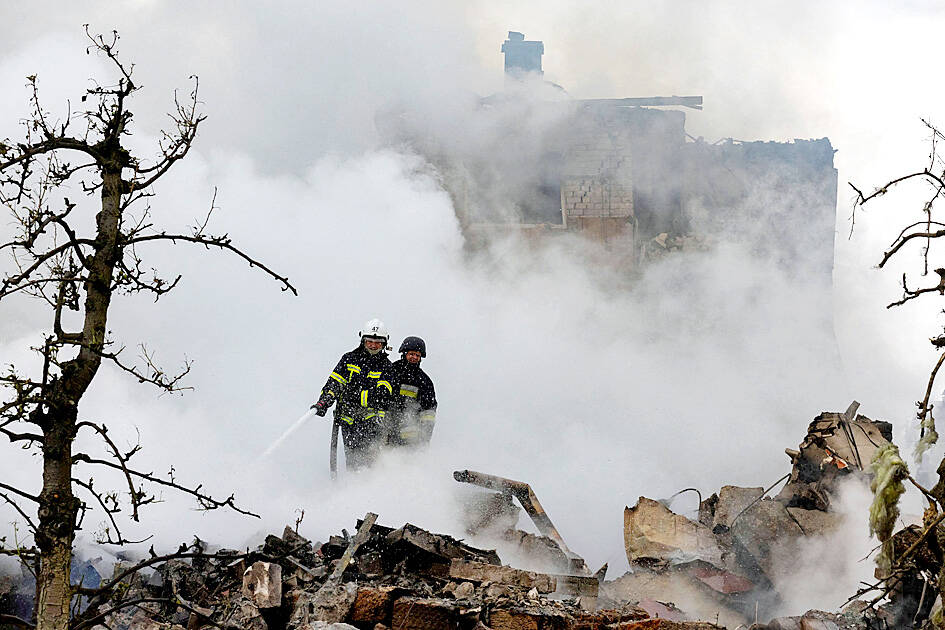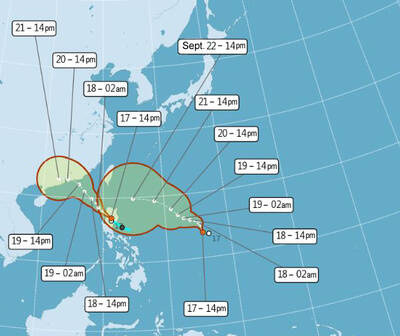Russian strikes killed at least 12 people in Ukraine overnight, officials said yesterday, as Kyiv and Moscow traded fire even as they completed their biggest prisoner exchange since the start of the war.
Ukraine’s emergency services described a night of “terror” as Russia launched a second straight night of massive airstrikes, including on the capital Kyiv.
The attacks came even as the two countries completed their biggest prisoner swap since Moscow launched its full-scale invasion in February 2022, with 1,000 captured soldiers and civilian prisoners exchanged by each side.

Photo REUTERS
The death toll from the latest Russian strikes included two children, aged eight and 12, and a 17-year-old, killed in the northwestern region of Zhytomyr, officials said.
“Without truly strong pressure on the Russian leadership, this brutality cannot be stopped,” Ukrainian President Volodymyr Zelenskiy said on social media.
“The silence of America, the silence of others around the world only encourages [Russian President Vladimir] Putin,” he said, adding: “Sanctions will certainly help.”
European Commission Vice President Kaja Kallas called for “the strongest international pressure on Russia to stop this war.”
“Last night’s attacks again show Russia bent on more suffering and the annihilation of Ukraine. Devastating to see children among innocent victims harmed and killed,” she wrote on social media.
The renewed strikes came after Russia launched 14 ballistic missiles and 250 drones overnight Friday to Saturday, which wounded 15, according to Ukrainian officials.
Ukraine’s military yesterday said that it had shot down 45 Russian missiles and 266 attack drones overnight.
Meanwhile, Russia said it had brought down 110 Ukrainian drones.
Four people were reported dead in Ukraine’s western Khmelnytskyi region, four in the Kyiv region, and one in Mykolaiv in the south.
Emergency services said 16 people were also injured in the Kyiv region, including three children, in the “massive night attack.”
“We saw the whole street was on fire,” a 65-year-old retired woman, Tetiana Iankovska, said in Makhalivka just southwest of Kyiv.
Another retiree who survived the strikes, Oleskandr, 64, said he had no faith in talks around a ceasefire.
“We don’t need talks, but weapons, a lot of weapons to stop them. Because Russia understands only force, nothing else,” he said.
Russia said yesterday it had exchanged another 303 Ukrainian prisoners of war (POW) for the same number of Russian soldiers held by Kyiv — the last phase of the prisoner swap agreed during talks in Istanbul on May 16.
Russia and Ukraine had over three days “carried out the exchange of 1,000 people for 1,000 people,” the Russian Ministry of Defense said.
Zelenskiy confirmed the swap was complete.
Both sides received 390 people in the first stage on Friday and 307 in the second stage on Saturday.
Russia has signaled it would send Ukraine its terms for a peace settlement after the exchange, without saying what those terms would be.
US President Donald Trump on Friday congratulated the two countries for the swap.
“This could lead to something big,” he wrote on social media.
Trump’s efforts to broker a ceasefire in Europe’s biggest conflict since World War II have so far been unsuccessful, despite his pledge to rapidly end the fighting.
An AFP reporter saw some of the formerly captive Ukrainian soldiers arrive at a hospital in the northern Chernihiv region, emaciated but smiling and waving to crowds waiting outside.
“It’s simply crazy. Crazy feelings,” 31-year-old soldier Konstantin Steblev said on Friday as he stepped back onto Ukrainian soil after three years in captivity.
One of the soldiers formerly held captive, 58-year-old Viktor Syvak, said that it was hard to express his emotional homecoming.
Captured in the Ukrainian port city of Mariupol, he had been held for 37 months and 12 days.
“It’s impossible to describe. I can’t put it into words. It’s very joyful,” he said.

Taiwan is projected to lose a working-age population of about 6.67 million people in two waves of retirement in the coming years, as the nation confronts accelerating demographic decline and a shortage of younger workers to take their place, the Ministry of the Interior said. Taiwan experienced its largest baby boom between 1958 and 1966, when the population grew by 3.78 million, followed by a second surge of 2.89 million between 1976 and 1982, ministry data showed. In 2023, the first of those baby boom generations — those born in the late 1950s and early 1960s — began to enter retirement, triggering

ECONOMIC BOOST: Should the more than 23 million people eligible for the NT$10,000 handouts spend them the same way as in 2023, GDP could rise 0.5 percent, an official said Universal cash handouts of NT$10,000 (US$330) are to be disbursed late next month at the earliest — including to permanent residents and foreign residents married to Taiwanese — pending legislative approval, the Ministry of Finance said yesterday. The Executive Yuan yesterday approved the Special Act for Strengthening Economic, Social and National Security Resilience in Response to International Circumstances (因應國際情勢強化經濟社會及民生國安韌性特別條例). The NT$550 billion special budget includes NT$236 billion for the cash handouts, plus an additional NT$20 billion set aside as reserve funds, expected to be used to support industries. Handouts might begin one month after the bill is promulgated and would be completed within

NO CHANGE: The TRA makes clear that the US does not consider the status of Taiwan to have been determined by WWII-era documents, a former AIT deputy director said The American Institute in Taiwan’s (AIT) comments that World War-II era documents do not determine Taiwan’s political status accurately conveyed the US’ stance, the US Department of State said. An AIT spokesperson on Saturday said that a Chinese official mischaracterized World War II-era documents as stating that Taiwan was ceded to the China. The remarks from the US’ de facto embassy in Taiwan drew criticism from the Ma Ying-jeou Foundation, whose director said the comments put Taiwan in danger. The Chinese-language United Daily News yesterday reported that a US State Department spokesperson confirmed the AIT’s position. They added that the US would continue to

One of two tropical depressions that formed off Taiwan yesterday morning could turn into a moderate typhoon by the weekend, the Central Weather Administration (CWA) said yesterday. Tropical Depression No. 21 formed at 8am about 1,850km off the southeast coast, CWA forecaster Lee Meng-hsuan (李孟軒) said. The weather system is expected to move northwest as it builds momentum, possibly intensifying this weekend into a typhoon, which would be called Mitag, Lee said. The radius of the storm is expected to reach almost 200km, she said. It is forecast to approach the southeast of Taiwan on Monday next week and pass through the Bashi Channel